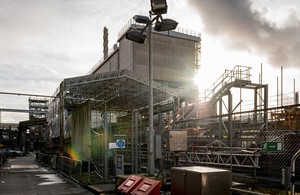Plugging a leak has put Sellafield on a path to a safer future
Adversity has been transformed into opportunity following a leak in a 60-year-old tank at Sellafield.

The Redundant Settling Tank area on the Sellafield site
The leak, from a sump in the Redundant Settling Tank area of the Sellafield site, was discovered last year.
Although the issue posed no immediate risk to people, it required urgent work to fix.
Despite a multitude of challenges, including the COVID-19 lockdown, the job was completed in just 9 months. And the work has helped accelerate decommissioning of the wider site.
Dorothy Gradden, Sellafield Ltd’s head of legacy ponds, explains:
If this had happened in the 1990s, it could have taken us years to fix it.
But because we’ve spent the last decade removing radioactive waste and sludge using remotely operated systems in other facilities, we were able to start fixing the problem in record time.
Working with our regulators and supply chain partners The Decommissioning Alliance, we decided the safest solution was to reseal the tank.
Simply pouring concrete in would have locked in the radioactive material, creating a decommissioning problem for future generations.
The Redundant Settling Tank is a relic from the 1950s. It sits next to Sellafield’s First Generation Magnox Storage Pond building and was used to store radioactive sludge taken from the outdoor pond.
The pond stopped operating in 1986 and the Redundant Settling Tank area was put into a care and maintenance regime in the 1990s, with decommissioning planned for the 2030s.
But that all changed on 19 October 2019.
Surveillance work found the level of liquor in a sump tank was reducing at a rate of approximately 80-100 litres per hour.
As there were no signs of a leak in the pipes connecting to other plants, it had to be assumed that the liquor was being lost to ground under or around the tank.
Experience gleaned from similar incidents indicated the liquor would bind itself into the clay in the soil underneath the facility, rather than migrating underground.
Dorothy added:
The focus was on keeping the engineering simple, fit-for-purpose and safe.
In total, 15 cubic metres of sludge and 15 cubic metres of solid waste needed to be moved.
Waste retrievals operations needed to be performed at a safe distance for humans while minimising any airborne contamination.
The Decommissioning Alliance came up with the idea of covering the area with a canopy and placing a remotely operated crane on a gantry above the tank to lower the necessary tooling to remove sludge and waste.
Larger waste items beyond the crane’s load bearing capacity would be cut up in situ before being lifted out and relocated in a ‘chop and drop’ system.
Within 9 weeks of the leak being discovered, we had defined the strategy, completed all off-site trialling and designed, procured and constructed the equipment needed to carry out the work.
So far, so good. But then, in March 2020, the COVID-19 pandemic intervened and the lockdown caused operations to be suspended.
Dorothy said:
We had to formulate a risk assessment to allow us to manage the additional risk of COVID-19.
This meant a new way of working which incorporated social distancing. Waste retrievals work restarted in June 2020 and by August 2020 we had successfully removed all the waste and sludge.
This allowed us to re-concrete the base of the tank to reseal it.
In September 2020 we installed an access point in the tank to help with future maintenance and officially retired the risk.
Next we will be using the new canopy and crane system to permanently remove the waste and sludge from other parts of the Redundant Settling Tank area therefore accelerating the decommissioning work to make the plant safe forever.
Lessons learned from the work are helping change the way decommissioning is carried out across the Sellafield site.
Dorothy added:
The need to address the immediate risk changed the parameters of the way the nuclear industry normally operates; everything had to be condensed and accelerated, while still being safe.
To have fixed a problem of this magnitude within a year of discovering it while also working around the new threat from COVID-19 has taken a tremendous effort.
There has been a huge amount of learning which we can take forward and use to improve our approach for other projects.
Our response to this serious incident has ultimately helped make Sellafield a safer place for the future.
Adrian Gate, project manager for the Decommissioning Alliance, said:
From developing the concept last October through design, infrastructure installation, waste retrievals operations, and the final phase of installation the integrated team from the Decommissioning Alliance and Sellafield Ltd have worked together seamlessly in a sustained effort to overcome a multitude of issues and technical challenges.
The successful outcome to this project in permanently resolving the problem and sealing the tank was hard-earned and fully deserved.